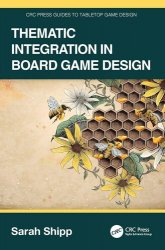 Название: Thematic Integration in Board Game Design Название: Thematic Integration in Board Game Design
Автор: Sarah Shipp
Издательство: CRC Press
Серия: CRC Press Guides to Tabletop Game Design
Год: 2024
Страниц: 161
Язык: английский
Формат: pdf (true), epub
Размер: 10.1 MB
Theme is often described as the "why" of a game. Themes help with rules comprehension by giving reasons for the mechanics. Themes can help set players’ expectations for what kind of experiences or emotions the game provides. Themes can also help to create the experience and provide atmosphere to the gameplay.
Thematic Integration in Board Game Design examines the design and integration of theme from the standpoints of technical structure, narrative building, and the design process. This book presents multiple approaches to designing theme as well as developing and replacing themes in existing projects.
The focus is on developing the design skill of mechanical integration of theme rather than developing creative writing skills. Multiple guides and exercises are included that designers can reference at various points in the design process.
Theme, as a game design term, is almost always discussed in relation to mechanics. Therefore, before an in-depth examination of theme as a concept, it is important to understand what board gamers mean when they say “mechanics.” Hunicke, LeBlanc, and Zubek define mechanics in their paper on MDA as “the various actions, behaviors, and control mechanisms afforded to the player within a game context.” Mechanics are not the same as rules. Mechanics are like a car. Rules are the steps you take to turn on the engine and begin driving. The “mechanics” of the car do not allow for flight, and the rules of driving the car do not allow driving on train tracks. Mechanics inevitably have a wider possibility space than rules. However, they are closely related enough that you can view mechanics as structural rules. For example, an auction is a mechanism for acquiring property in the card game For Sale, but the rules dictate how much money the players start the game with. Game design language is still evolving. My personal view is that the terms mechanics and mechanisms function similarly to “people” and “persons.” Mechanics describe whole structural systems or categories, whereas mechanisms describe individual structures that happen to coexist. Mechanism is the better term for a single mechanical structure, as a mechanic is a person who works on cars.
Board game themes use the more common definition of theme, a subject or topic. We see this usage in theme parks and themed parties. If you were invited to a costume party, you might ask, “What’s the theme?” This definition and general usage meshes well with how themes were most commonly presented in board games until relatively recently: as window dressing. By this definition, theme is a costume a game wears depending on what the publisher thinks will sell. We are now stuck with the term even as board games move on to more integrated themes.
Key Features:
Fills a void in board game design theory by discussing theory-craft relating to theme in board game design
Presents practical theory for working designers or students
Focuses on developing the design skill of mechanical integration of theme rather than developing creative writing skills
Скачать Thematic Integration in Board Game Design (CRC Press Guides to Tabletop Game Design)
|